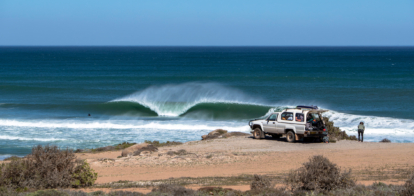The Real Hidden Gems of the West Coast
Big Mineral Mining is tearing up the coastline and restricting access to some of South Africa’s most pristine beaches and waves—and it’s getting way out of hand.
Stretching hundreds of miles north of Cape Town, South Africa, the sparsely populated Cape West Coast is a wild, haunting place. Flanked by the Cederberg Mountains to the east and the cold Atlantic Ocean to the west, its coastline boasts a multitude of hidden gems—pristine environments, coastal communities and world-class waves with enormous recreation and tourism potential, from diving and fishing to trail running, surfing and kiting. The region is also a biodiversity hotspot with a rich Indigenous past.
But today, powerful mining companies are here hunting a different kind of treasure—one that’s turning the West Coast into a battleground between Cape Town’s citizens and Big Mining backed by the government.
Australian-owned Mineral Sands Resources’ (MSR) Tormin Mine, which lies on an isolated stretch of coast near the Olifants River estuary, an area home to wetlands and fragile biospheres, is one of the main operators. Recently, MSR was granted a controversial extension to its existing mining operations in an area north of the Olifants River—referred to as the “10-beach extension”—that prohibits public access to several beaches and quality surf spots.
“When I tried to surf on the beaches that MSR are mining, there were ‘No Entry’ signs all over the place, and security there is always super tight,” said South African big-wave surfer and Patagonia Ambassador Mike Schlebach. This prompted Mike to form the nonprofit Protect the West Coast (PTWC). Incensed by the destruction and barring of public entry to the beaches, I joined the cause as PTWC’s media liaison.
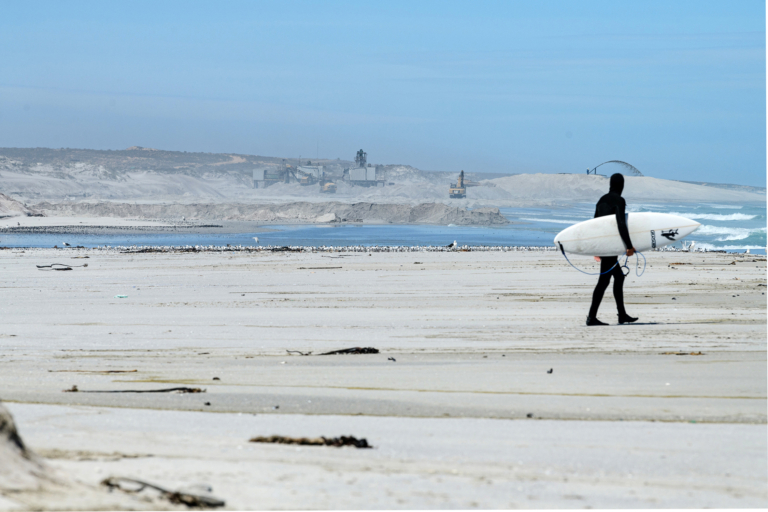
Patagonia Surf Ambassador Mike Schlebach looks out at the unwanted machinery digging up South Africa’s precious coastline. Photo: Xavier Briel
Led by several activist groups, including PTWC, local citizens are resisting the recent push by mining companies to extract the valuable heavy minerals that line coastal sands, and which require these companies to close vast stretches of shoreline to the public as they rip up the landscape to get the resources below.
“There is less and less access and now more coastline is being given to mining than to citizens,” explains West Coast anti-mining campaigner Suzanne Du Plessis, who has been fighting this threat for years.
In the past, most mines were located much farther north, in a sparsely populated region, where there are less than three people per square kilometer. But the mining companies are getting greedier by expanding their operations and applying for new mining or prospecting rights in the more populated southern region of the West Coast, in what Suzanne called “an avalanche of applications.”
Away from the public eye, miners use giant machines to tear at the beaches and transport truckloads of sand to processing plants where the grains are then separated from the minerals. For the beaches, the level of carnage is akin to a battle zone; the coastal terrain is often irrevocably reduced to sterile piles of sand and gashes.
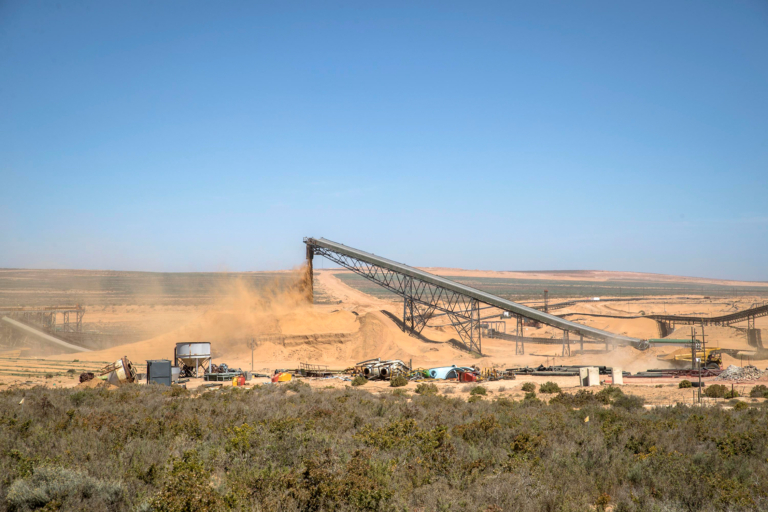
Out of sight, out of mine. The mining companies export the gems and minerals and exile the public. Photo: Alan van Gysen
On top of it all, the mining companies seem to be ignoring Indigenous land rights along with the public’s constitutional right to access the coast. Many of the areas currently being mined or prospected feature world-class surf spots frequented by local South African surfers and the international surfing elite. If the mines expand, these spots will be widely shut down and heavily guarded against surfers, anglers and the general public.
“Mineral rights become higher than public rights,” Jan Engelbrecht, a local farmer, coastal landowner, activist and PTWC ally told me.
Foreign mining interests have also recently taken over a mining concession on an old farm just outside of Kleinzee, barring public access to a stretch of shore that is home to a great right-hand point break and several untouched beaches. They now, too, are out of bounds with armed guards blocking fair passage to another chunk of the West Coast. One must wonder: Where will it end?
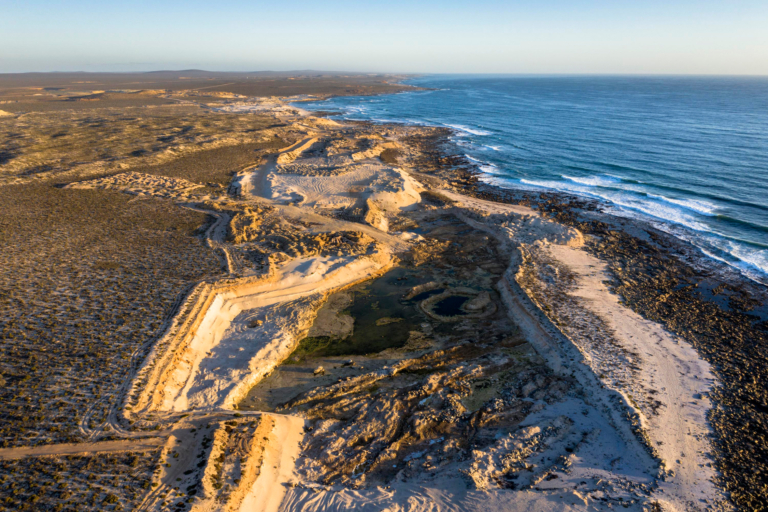
Chewed up and spit out. More often than not, big mining companies have no solution for their damage—nor do they seem to care. Photo: Alan van Gysen
Predictably, these mines are a divisive presence in the region. Prone to drought, the West Coast is a financially embattled and socially disparate place where sparsely situated towns and farming communities eke out a living from farming, fishing and tourism. The longstanding justification for mining here is economic stimulation. But there is little evidence of meaningful investment in the communities by mining companies, just a seemingly reckless disregard for the environment and the local people, exacerbated by secretive applications that allow limited public knowledge or participation in the approval process while these companies profit from the land at the locals’ expense.
In South Africa, one aftereffect of apartheid means that much of the inland areas are owned by farmers while the coastal zones are public land managed by the African National Congress. In the past, farmers have aggressively prevented people from camping on or crossing their lands to access the coast, but lately have taken a softer approach because they realize this is not fair or sustainable. Part of the problem, according to Jan, is that the local authorities who should be providing access via legal public servitudes are not. “Municipalities have to create road access and control, build fences and create ablutions and camping facilities,” he says, “but they don’t have any money to do so.” Instead of the mining companies creating access to where the public has the right to go, the coast is locked behind fences and patrolled by hired security. Add widespread allegations of corruption and a government that favors the mining companies’ revenue over its people, and you have a difficult and complex problem.
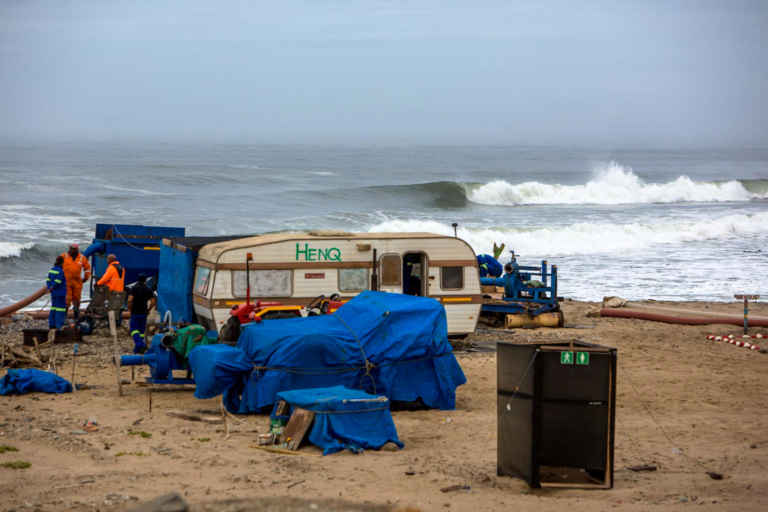
The righthander in the distance is not the only finite resource that’s pumping. Photo: Alan van Gysen
Yet, wider community resistance to mining has increasingly brought local people, still fragmented in the aftermath of apartheid, together in new ways. Representatives of the Indigenous Khoisan community, who are fiercely protective of their right to access their traditional grounds, are standing side by side with eco-activists, anglers and farmers at public meetings against sand mining and prospecting applications, which are becoming increasingly well-attended. “This land is our heritage,” said Khoisan Senior Chief Johannes Lynx to unified applause at one packed and emotionally charged meeting in the fishing village of Lamberts Bay. “We say no to mining anywhere on the West Coast.”
“The mining companies use the Trespass Act to keep us from [practicing] our way of life through the gathering of known marine species,” Chief Lynx later said. “Together, we can ensure that our environment will be protected against greediness and our descendants will enjoy it for centuries to come.” Artisanal fishers also worry encroaching mines will try to enforce the heavy-handed restrictions they have gotten away with for years farther north. “This is something that would have dangerous consequences for the livelihoods and food security of fishing communities,” said Carmen Mannarino, a program manager for Masifundise, a regional initiative that assists small-scale anglers.
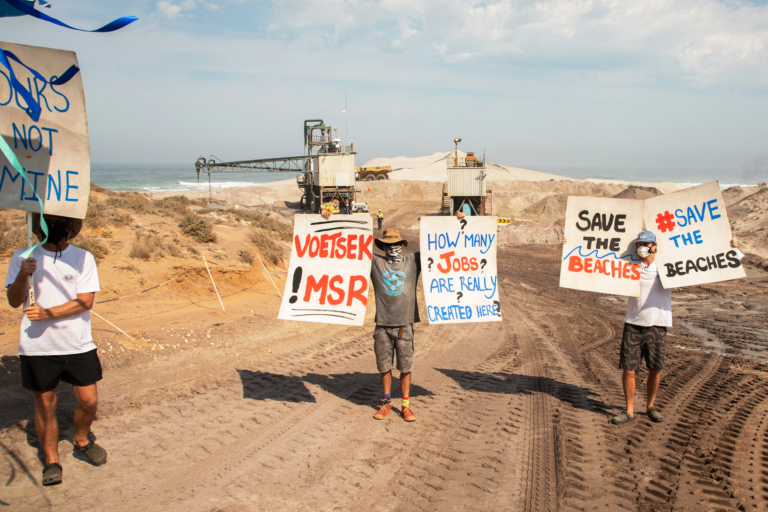
Protect the West Coast take to their beaches and let their voices be heard. Photo: James Lowe
In April 2021, we staged our first public protest—a picket line led by Mike and an unauthorized trail run through the Tormin Mine—to attract attention and question the legality of the restrictions. Dom Jesus, who led the runners, said they were confronted by hired security “who got heavy with us and told us to get all the runners off the beach” or face arrest. According to Dom, the Tormin Mine has effectively blocked public access to a 30- to 40-kilometer (18–24 miles) stretch of coast, home to several great surf breaks and swathes of unspoiled scenery that’s destined to be destroyed.
In August, we held another activation at 13 of Cape Town’s most popular beaches, where we cordoned off sections of sand and placed “No Trespassing” signs, like those at the Tormin Mine, to enlist public awareness and support. We also recently partnered with the Amandla Surf Foundation who put on a specialty professional surfing event, the Namakwa Challenge, near the Tormin Mine. While some hardcore West Coast surfers lamented the fact that the event was held at a “secret spot,” Mike was more pragmatic. “Surfing, tourism, sports, fishing, conservation, agriculture, etcetera, are all viable and sustainable long-term alternatives to mining in that area,” he said. “Mining is taking over the entire West Coast, and if we don’t promote these alternatives, there will be no surfing or anything else there in the future.”
So far, thanks to its activations and media coverage, PTWC has enjoyed widespread publicity around the issue and built up strong public support and a sound social media following. We also recently released a movie about the situation, Ours, Not Mine, and have several plans for further awareness drives, as well as assisting the legal challenges that are mounting against the mines. But whatever happens in the future, it is the people of the region who must resist the exploitation of their natural resources and stand up for their right to access the coast.
Fortunately, we are more than up for it. Our fight has just begun.
Help save this magical stretch of coastline by volunteering, donating, following along on social media or signing the petition. Learn how at Protect the West Coast.
